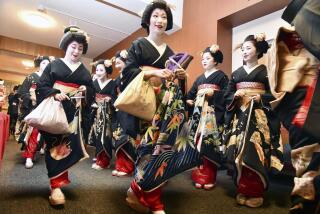‘Tomb Taboo’ Foils Probes Into Japan’s History
- Share via
ASUKA, Japan — History buffs in hiking boots file past an old caretaker, who sits quietly reading the morning paper. Like thousands of other visitors each year, they seek the tomb of Emperor Kinmei, who died in 571.
But which tomb is it--the government-designated one, where this group is headed, or a nearby imperial mausoleum that is overgrown and largely ignored?
Scholars have argued for decades that many royal tombs are wrongly identified. When they try to have a closer look, however, archeologists run into the “tomb taboo,” which helps keep much of Japan’s early history veiled in myth and mystery.
The imperial palace, which has jurisdiction over the sites, says they are sacred, not to be defiled.
“The tombs are an important source of historical information,” said Hiroshi Tsude, a professor at Osaka University. “We need access to them.”
Masashi Ishibe, head of the Japanese Archeological Assn.’s tomb division, said the palace “has severely infringed on our academic freedom.”
In December, a television network resurrected the dispute by broadcasting photographs taken at a burial site outside this farming village, where more than a dozen tree-covered funerary mounds jut from the rice paddies.
A villager with a camera crept into the 350-yard-long tomb known as Mise Maruyama, which is shaped like a keyhole, through a forgotten opening near a public playground outside the barbed-wire fence.
His vivid photos showed two sarcophagi, the lid of one left askew by grave robbers, in a spacious burial chamber formed by slabs of granite estimated to weigh up to 100 tons.
Many archeologists believe the size and style of the chamber and its contents confirm that it is the tomb of Kinmei and his consort, Kitashihime.
Kinmei is known to history students for introducing Buddhism from Korea. It quickly became a central element of Japanese culture.
Harutake Iikura of the Imperial Household Agency, which manages palace affairs, said it has no intention of opening a new study of either site and is considering legal action over the intrusion.
“It is like having someone break into your home,” he said.
The opening to the Mise Maruyama tomb has been filled with concrete.
Nearly 200 royal tombs are supervised by the palace agency. Iikura said most older mausoleums with unclear origins were classified in the mid-19th Century.
Tsude, of Osaka University, said the government of that time relied heavily on old history texts, which are largely allegorical, in designating the tombs.
Questioning the palace, and thus the divine emperor, was an offense punishable by imprisonment until the end of World War II. Since then, archeologists have frequently expressed doubts about many of the designations.
“The Imperial Household Agency is really in a bind,” Tsude said. “They are afraid that if they open the tombs up to archeologists, they may find that all of their designations are wrong.”
Akihito, the current emperor, is No. 125 in the line of emperors by the traditional count, which includes several whose existence is open to debate. Legend says the first emperor, Jimmu, ascended the throne in 660 BC.
Most historians believe the monarchy originated sometime before the 5th Century, but conflicting theories abound. Some even trace the imperial bloodline to mainland Asia.
Some archeologists express a degree of sympathy for the palace.
Kanekatsu Inokuma, an archeologist in Asuka, noted that descendants of the entombed Japanese emperors still reign, unlike in Egypt, where the pyramids are open, and other countries with ancient burial monuments.
“In a way, that makes them family graves,” he said. “It brings some special sensitivities into it.”
More to Read
Sign up for Essential California
The most important California stories and recommendations in your inbox every morning.
You may occasionally receive promotional content from the Los Angeles Times.













